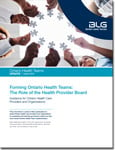This is the third in a series of BLG publications to assist Ontario health care providers and organizations to understand and develop governance options as they work toward Ontario Health Team implementation.
OHT Update 3 – August
(PDF, 2.43 MB)
In June of 2019 the Ontario government proclaimed the Connecting Care Act, 2019 (the CCA) in force.
The CCA establishes Ontario Health as a province-wide agency, which will eventually exercise many of the powers that have been exercised by Local Health Integration Networks.
The CCA also enables the designation of integrated care delivery systems which are being referred to as Ontario Health Teams (OHTs). Once designated by the Minister of Health (Minister), an OHT will be treated like a health service provider for the purposes of the CCA. This means that there will be a single funding and accountability agreement between Ontario Health and an OHT. An OHT will also be treated as a single entity for the purposes of reporting and in respect of further integrations. In particular, a Minister's integration order requiring an integration to occur may be issued to or in respect of an OHT. An OHT can be the recipient of a transfer of any of the operations of the LHIN, including home care, pursuant to a Minister’s transfer order.
OHTs will be comprised of persons, entities or groups that have the ability to deliver, in an integrated and co-ordinated manner, at least three of the following services:
- Hospital
- Primary care
- Mental health or addictions
- Home care or community care
- Long-term care home
- Palliative care
The Ministry of Health (Ministry) is not prescribing a governance model for OHTs. It is expected that OHT participants will include a wide range of different for-profit and not-for-profit entities and organizations and that the governance structure will evolve over time.
While the Ministry has provided guidance on minimum governance requirements for OHTs, it has also made it clear that governance arrangements for OHTs will be “self-determined and fit for purpose.”
Boards of those entities seeking to become members of an OHT will play a key role in supporting the formation of OHTs. At least in the initial years, such boards will likely retain their independent governance structures but will oversee the formation of a governance structure or decision-making framework for the OHT. This publication is intended to assist health provider boards in understanding their role in the early stages of OHT formation and to provide some guidance on core elements of an OHT governance framework in year one.
The Board’s First Role – Knowledge and Setting the Stage with a System Perspective
The fiduciary duties of board members require that decisions are made in the best interests of the corporation served: the health service provider. The question is often asked: “How do we reconcile system interests with our organization’s best interest?”
A board of a publicly funded, mission-driven organization should define “best interests” with regard to the mission, vision, values and accountabilities of the organization. Accountabilities will be varied and include: patients/clients, regulators, funders, donors, taxpayers, academic partners, the community served, etc. These varied accountabilities cause the board to have regard to the health system.
Consideration must also be given to the statutory mandate that applies to health service providers that are subject to the CCA:
The Agency [Ontario Health] and each health service provider and integrated care delivery system [OHT] shall separately and in conjunction with each other, identify opportunities to integrate the services of the health system to provide appropriate, co-ordinated, effective and efficient services.
Accordingly, boards of health service providers subject to the CCA must also have a health system perspective. Looking at the organization through a system lens will impact key areas of board role and function including:
- Strategic planning
- Recruitment, both at a board and management level
- Stakeholder relations and engagement
- Expectations of the board chair
- Expectations of management
Boards should:
- Stay current on OHT guidance provided by the Ministry.
- Be informed about health trends, the health system and in particular the other providers, agencies and organizations that will be eventual participants in an OHT providing the full continuum of integrated care. Ask these key questions:
- What does a continuum of co-ordinated and integrated care look like?
- Who are the players in providing care? Who else cares for our patients or clients?
- What is the target population initially and at maturity?
- Identify key stakeholder organizations and look for opportunities to build board-to-board relationships; such relationships can facilitate opportunities for integrating care by building trust and confidence.
- Develop a “system” approach to decisions. Evaluate decisions with reference to a system perspective. Where appropriate, boards should ask questions such as: “Have we talked to other key stakeholders in the system with respect to this initiative?”; “How will this impact the system and other healthcare providers?”; “Will this help us partner with other providers or will it create barriers to integrated care?”
- When the opportunity arises, participate in collaborative governance forums. If no such forums have been established, consider working with other health service providers to establish collaborative governance discussions facilitated by a neutral party.
Boards will also need to become comfortable with uncertainty in the early years as OHTs are initially formed with less formal arrangements and as OHT governance may evolve and change as new members are added to the team over time.
The Board’s Second Role – Demonstrating Leadership
Our experience is showing that initial discussions about OHT formation are being initiated and led by senior management. This is not surprising given the focus on identifying a year one target population of patients and developing an integrated care model for those patients: this is work that would typically fall to management.
The board will become more engaged as the governance decision-making framework for the OHT is being established. Initially, board level discussions may involve only a small group of board members, perhaps just the chair and vice chair, before expanding to engage the full board. Accordingly, a key accountability falls to the board leadership to support management, engage directly with their respective counterparts at other organizations and to determine the appropriate point at which to engage the board more fully. Once engaged, the board needs to provide support to the CEO, the senior management team and the board chair.
It is also important that the board recognize the workload that will fall to management in the context of creating on OHT and fulfilling the year one mandates. These roles will be in addition to the ongoing roles of the senior management team. Guidance and leadership from the board plays a valuable role in supporting management through the process.
Leadership also involves recognizing the differences in the organizational capacities of team members to contribute resources, both financial and human resources. One or two team members may be called on to make a larger contribution of resources as the team is forming. The team members should not let the level of contribution impact the guiding principles that have been established with respect to decision-making (i.e., equal voices). Consideration should be given to the use of a neutral facilitator or impartial third party as chair of the OHT governance organization to ensure guiding principles are followed and to assist in trust building.
The Board’s Third Role – Define and Refine Principles for Participation
Successful integrations happen when all parties share a set of common objectives and guiding principles that are clearly defined at the outset of the process. Specific implementation decisions are then made with reference to those objectives and guiding principles.
The ultimate objective of an OHT is to provide the full continuum of integrated and co-ordinated care to a defined population. Accordingly, the parties will wish to ensure they maintain a patient/client focus.
Guiding principles should:
- Take an evolutionary approach to OHT formation that will allow for adding team members from time to time and for team members to have varying levels of participation and engagement particularly in the early stages;
- Accept that form will follow function and the governance or decision-making structure of the OHT will change over time;
- Include principles of decision-making and dispute resolution;
- Ensure all participants support transparency not just among active participants but also with those who may initially have an observer or supporter status; and
- Suspend any assumption of leadership roles—leads may move from time to time and should not be assumed based on budget size.
Many boards may start with a list of “non-negotiables”—boards should limit such a list to factors that are truly critical to the success of the OHT shared vision for a continuum of integrated and co-ordinated care.
In many cases there may not be objectively measurable criteria with which to conduct a cost/benefit analysis of the proposed integration of care. This is particularly true where the vision is for improved access and quality of care. Boards must appreciate that the business case for a particular model of patient care integration may be subject to less measurable criteria than would typically apply in a commercial transaction.
The Board’s Fourth Role – Engagement
While the Ministry is requiring an OHT that involves two or more entities to have a formal agreement among the team members, there is no Ministry requirement about the level of formality of that agreement or the decision-making framework that should be established among team members.
It is anticipated that the decision-making framework or governance structure in year one will be less formal and may take the form of a collaboration steering committee or joint venture leadership committee. Given the year one scope, management will likely be more involved in the OHT decision-making framework than board members from the respective team participants. The OHT formation agreement will outline decisions that can be made at the leadership level and those that will require approval of the boards of the team members.
It is important that the members of any steering committee or decision-making body not get too far out in front of the full board with respect to decision-making. Mechanisms to communicate progress to the respective boards and ensure buy-in at key milestones will be critical to the eventual success of the OHT.
Board members may be asked to participate in various working groups, sub-committees or strategy “tables”.
Board members should participate in such opportunities when requested, and should stay involved in the process even where they are not assigned a direct role and should receive and respond to reports.
Once the guiding principles have been defined, a board should from time to time refine and evaluate those principles in collaboration with other team members.
Board members should participate in stakeholder engagement as appropriate and requested.
Lastly, it is important that the board continue to govern and exercise oversight of its own organization during the formation of the OHT. We believe that successful integrations and collaborations occur when participating health providers have adopted similar governance best practices. As OHTs develop, team members and potential team members have an opportunity to assess and improve their own respective governance and to share governance best practices across team members.
The Board’s Fifth Role – Approvals and Oversight
There may be a non-binding memorandum of understanding or letter of intent or similar document presented to the board which outlines key terms of the initial formation of the OHT.
Such a document ensures that there is a “meeting of the minds” on key aspects of the OHT. If the parties have been talking in general terms, reducing key elements of the proposed OHT to a non-binding memorandum of understanding or letter of intent ensures that there is a common vision, objectives, and criteria and that non-negotiables (if any) are understood. This avoids getting too far down the road only to find out that there is a fundamental disagreement in the nature of what the parties intend to achieve. This document can also map out key steps in the process such as the approach to a communications plan.
The board should not expect that every question will be answered at this stage. A memorandum of understanding provides a high-level road map for the initial formation of the OHT.
Boards should ensure that an implementation plan is established and monitor any conditions that are required for final approval. Boards should also be prudent in deciding what needs to be part of the initial OHT decision-making or governance structure and what can be left to be decided as the work of integrating patient and client care evolves and new members are added to the team.
Once the final documents are settled, the board gives final approval: the board must then stay involved and continue to govern. The board will be asked to make specific decisions in accordance with the agreed decision-making/ governance framework. In making such decisions in respect of the OHT the board must continue to be guided by the agreed guiding principles.
Summary
The development phase of OHTs provides an opportunity for the boards of participating organizations and those who will be future participating organizations to focus on various board roles that will contribute to OHT success. In particular, boards can work to ensure delivery of the future vision of a full continuum of co-ordinated and integrated care for their defined patient/client populations.
Additional Resources
The Guide to Good Governance: Not-for-Profit and Charitable Organizations (2013). Co-authored by Anne Corbett, Partner with BLG and Jim Mackay of Berkeley Consulting and published by the Ontario Hospital Association, offers governance tools, templates and guidance as a resource for developing and implementing the governance best practices referred to in this publication.
While the Ministry has provided guidance on minimum governance requirements for OHTs, it makes clear that governance arrangements for OHTs will be “self-determined and fit for purpose.” Good governance is key, not only for the operation of OHTs, but for individual providers, as a key ingredient in successful collaboration.
As providers and organizations come together at various stages in the OHT development process, they are looking for guidance with respect to OHT governance options, as well as solutions to provide structure and rigor to the development and decision-making required to form and operate OHTs.
BLG has released Governance Options: Getting Started and Evolving Towards Maturity (April 2019), which describes options for OHT governance, and Governance Best Practices for High Performing Boards (August 2019), which describes governance best practices relevant to OHT participants.


